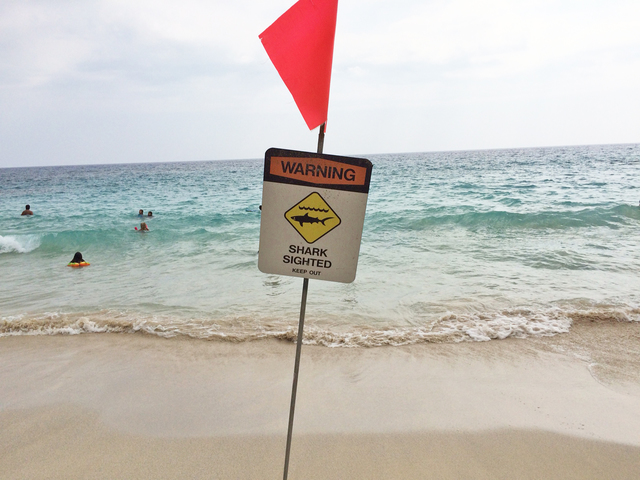KAILUA-KONA — The Department of Land and Natural Resources is urging ocean goers to use extra caution this month, as shark encounters tend to peak in Hawaii during the fall season. ADVERTISING KAILUA-KONA — The Department of Land and Natural
KAILUA-KONA — The Department of Land and Natural Resources is urging ocean goers to use extra caution this month, as shark encounters tend to peak in Hawaii during the fall season.
Over the last 35 years there have been 122 unprovoked shark attacks in Hawaii waters. Of those 122 attacks, more than one in every five have happened during October.
“October is the month with the greatest number of shark bites,” said Division of Aquatic Resources administrator Bruce Anderson. “We recommend ocean users exercise a little more caution this month especially, and also through the end of the year. The chance of being bitten by a shark in Hawaiian waters is always extremely small, but does increase a bit during this time frame.”
Research conducted at the University of Hawaii confirmed that attacks are statistically more likely during fall months, specifically October. The explanation researchers offered is that roughly one in every four female tiger sharks that typically inhabit the Northwestern Hawaiian Islands migrate to the main islands during fall to give birth.
A combination of a higher concentration of sharks in popular Hawaiian waters and a greater need to feed due to depleted energy stores may play a primary role in increasing the likelihood of shark bites, researchers explained.
The recent history of October shark bites has been consistent. Two bites occurred during the month in 2012, three in 2013, four in 2014, and three last year. All three attacks in 2015 occurred off the shores of Oahu.
One October attack in 2014 that garnered national coverage occurred in at Keawaeli Bay off the Big Island. McKenzie Clark and Brian Wargo, captain of Bite Me Sportfishing, were surfing in the waters off Halaula Lighthouse a little after 10 a.m. on the morning of Oct. 31.
Wargo missed a wave, and after it passed, he noticed the screaming coming from behind him.
A tiger shark upwards of 15 feet in length had flung Clark out of the water in its first attempt to attack her, and the first thing Wargo saw as he turned to the terrified shrieks was his surfing companion suspended above the emerged beast’s thrashing jaws.
The shark drew blood on its second run, sinking its teeth into Clark’s left hand and her surfboard simultaneously. Wargo was eventually able to get on top of the shark after Clark ripped her own hand from its mouth, gripping its dorsal fin with both of his hands.
As the animal began its third pass at Clark, it came close enough to the surface for the 6-foot-3, 240-pound man to begin landing blows with his fist to the shark’s gill area. Wargo recalled on the fifth punch or so, he felt the shark shudder underneath him, after which it turned away and retreated into the depths of the ocean.
“The statistics say it’s pretty rare it’s going to happen,” Wargo said. “If something ever did happen, you have to keep the state of mind to fight. Most people that have fought them have reduced the (damage). And they do go away if you fight them.”
Both Wargo and Clark have continued to surf, although Clark has never returned to the scene of her attack on a surfboard and Wargo has only gone back once.
Wargo said his advice to people wouldn’t be to avoid the water, but instead to just keep apprised of conditions that make shark attacks more likely: the time of year, the time of day — at dusk or dawn — and a cloudy quality of water all among them.
Still, he said, that’s no guarantee, as his extremely close encounter with a tiger shark didn’t fit the traditional bill.
“It was 10:20 in the morning, a beautiful sunny morning, and in (relatively) clear water,” Wargo said. “It didn’t fall into the categories of all the attack statistics, but it happened all the same. When they’re hungry and they want to eat, it’s hard to say what triggers them.”
More information and advice about shark safety can be accessed at the DAR website, hawaiisharks.org.
“The best thing ocean users can do to minimize their risk of shark bites is to utilize beaches with lifeguards, stay near other people, and don’t go too far from shore,” Anderson said. “Also, avoid murky water and areas near stream mouths.”




